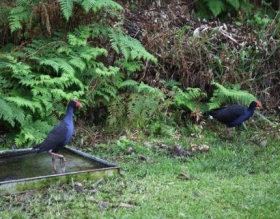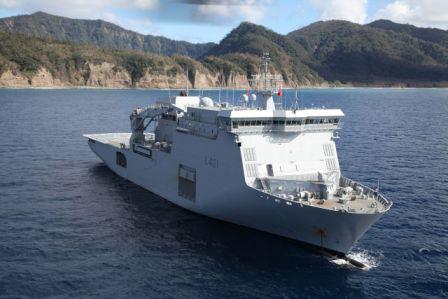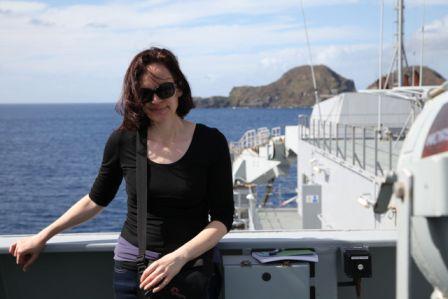Kermadecs Islands: Becoming a Raoulie

Kermadec petrels (Pterodroma neglecta) and Kermadec white-faced storm petrels (Pelagodroma marina albiclunis) have been landing on the deck of the ship. These seabirds breed on Raoul Island and the nearby Meyer Islands, and plummet down from their cliff-side nests to feed in the ocean. With a diet of small squid, fish and krill, they are as much a part of the marine ecosystem as the large fish predators. Sometimes, though, the birds are prey. On his last trip to the Kermadecs, Clinton found three Kermadec little shearwaters (Puffinus assimilis kermadecensis) in the belly of a kingfish.
Clinton the shark man has a soft spot for birds, too, and each time a disoriented petrel is found on the ship he takes it to the upper deck of the HMNZS Canterbury – to mimic the cliffs they nest on – and encourages it to fly off.
We had our own flight yesterday morning. The wind was up and the swell had increased. It wasn’t safe to come ashore by boat so we flew to the island in the Navy Seasprite helicopter.

The HMNZS Canterbury at anchor next to Raoul Island.
Where we landed, on a grassy field, the grass and surrounding trees were filled with familiar looking land birds – pukeko, tui and kakariki. But they are different to the birds we know from New Zealand – the pukeko are skinnier, the tui are greener and the kakariki are fearless.
It’s very busy on the island. The new Department of Conservation team are learning the ropes and getting to know the island and its flora and fauna. The Geonet team is checking their monitoring equipment – seismographs, tsunami gauges and lake level monitors. The MetService team is repairing cyclone damage to the shed – locals call it the bomb shed – where Roulies fill the daily hydrogen balloon.

Author at sea
Many of the island’s nikau and pohutukawa were felled by the recent cyclone, and many of the standing trees suffered salt damage from sea spray. As well as occasional cyclones, the island is prone to volcanic eruptions, earthquakes and landslides. That’s enough for the birds to cope with without humans adding to the problem. Early visitors to these islands brought kiore (Pacific rat), the Norway rat, cats, pigs and goats. They’ve all been successfully eradicated and now the Department of Conservation is concentrating on eradicating exotic flora.
This island is only two million years old so all the native species here, on land and in the rocky reefs around the island, arrived by dispersal, from New Zealand, Australia or the Pacific Islands. We’ve been arguing about how the pukeko got here. We have them in New Zealand, but they can’t fly more than a few feet. Some people think they blew here on a big storm. Others think that visiting Maori voyagers brought them here in their waka (canoes). After last week’s excitement with the pumice, I think they came here on a raft of pumice.
Speaking of which, Helen Bostock found a line of pumice at the shoreline on Denham’s Bay. It was irregular in shape, which means it’s young, and she thinks it’s from last week’s “event”.
This article is repurposed from the Scientific American.
About the Author: Dr Rebecca Priestley is travelling on the HMNZS Canterbury as part of a Sir Peter Blake Trust voyage to the Kermadecs. With degrees in earth sciences and the history and philosophy of science, Rebecca is part of a team of experts selected by Pew Environment Group to join the voyage to this remarkable and remote ocean wilderness two-days sailing northeast of New Zealand’s North Island. Pew is encouraging the New Zealand Government to protect the Kermadec region and the rich biodiversity there by creating one of the world’s largest ocean sanctuaries. Rebecca will working closely with the voyage’s scientists – marine biologists, volcanologists and conservation workers – and will report on the team’s daily adventures and discoveries. While Rebecca has written about the Kermadecs before – you can read her essay about the region’s history and wildlife here – this will be her first visit to the region, and her first long sea voyage. Rebecca’s academic specialty is New Zealand’s nuclear history, but she writes widely about science and science history, including a regular science column for the New Zealand Listener and a personal blog at rebeccapriestley.com, where she wrote about her 2011 trip to Antarctica. She tweets @RKPriestley. Rebecca lives by the ocean in Wellington, New Zealand. Follow on Twitter@RKPriestley.







